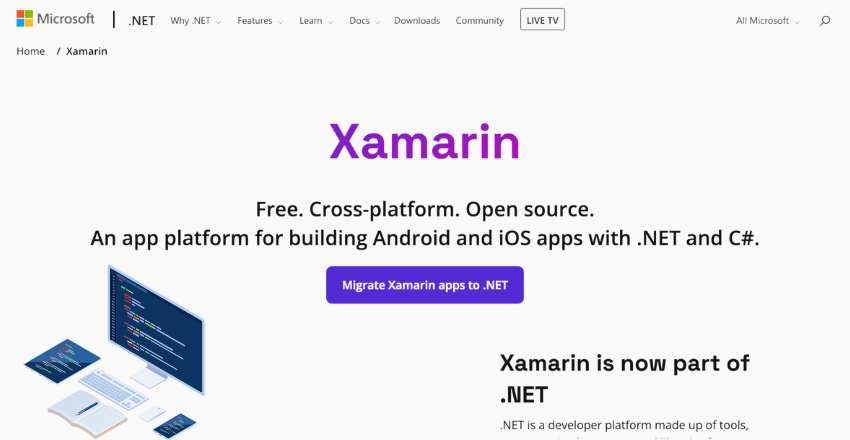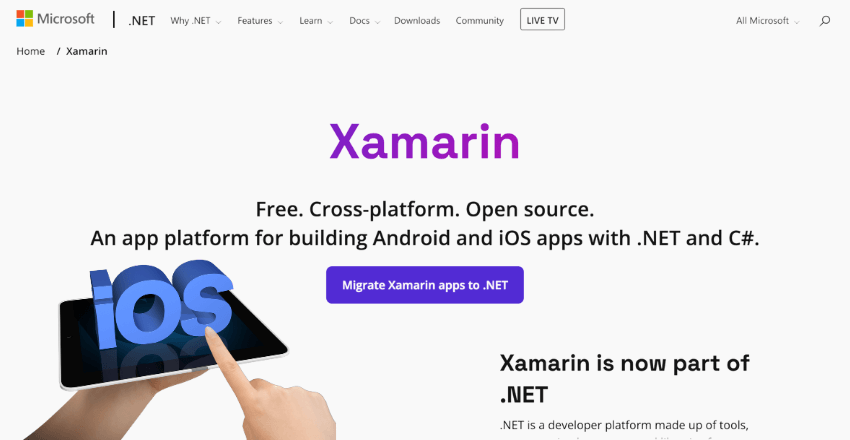 In today’s fast-moving world, creating mobile apps that can run seamlessly on multiple platforms has become a challenge for developers. That’s where Xamarin comes into play. With Xamarin, developers can build mobile apps that work on iOS, Android, and Windows using a single codebase. This means faster development, reduced costs, and greater reach for your app.
In today’s fast-moving world, creating mobile apps that can run seamlessly on multiple platforms has become a challenge for developers. That’s where Xamarin comes into play. With Xamarin, developers can build mobile apps that work on iOS, Android, and Windows using a single codebase. This means faster development, reduced costs, and greater reach for your app.
Xamarin is a mobile app development platform that uses C# and the .NET framework to create native mobile apps for iOS, Android, and Windows. Xamarin provides a powerful and flexible environment for developers and enables them to reuse a significant portion of their existing code.
One of the key benefits of Xamarin is its cross-platform compatibility. This feature allows developers to write one codebase that can be used across multiple platforms. This reduces development time and costs while increasing the efficiency and effectiveness of the development process. With Xamarin, developers can create cross-platform mobile apps that are fast, reliable, and secure, providing an optimal user experience.
.NET Xamarin
Mobile app development has become increasingly popular in recent years, with more and more businesses looking to develop their own mobile apps to reach a wider audience. However, with so many different mobile operating systems on the market, developing an app that can run on multiple platforms can be a challenge. This is where .NET Xamarin comes in handy.
.NET Xamarin is a cross-platform development framework that enables developers to create native mobile apps using the .NET framework. With Xamarin, developers can write code once and deploy it to multiple platforms, including iOS, Android, and Windows.
This greatly simplifies the app development process and allows developers to reach a wider audience without having to write completely different code for each platform.
One of the key advantages of using Xamarin for cross-platform mobile app development is that it allows developers to use a single codebase for all platforms. This means that developers can write C# code and share it across iOS, Android, and Windows projects. This saves a lot of time and effort compared to writing separate code for each platform.
Another advantage of Xamarin is that it provides a rich set of tools and libraries to enable developers to build high-quality, robust mobile apps. These tools include Xamarin.Forms, which allows developers to create cross-platform user interfaces, as well as Xamarin.Android and Xamarin.iOS, which provide platform-specific APIs and tools for building native Android and iOS apps using C# and .NET.
Cross-Platform Mobile App Development with Xamarin.Forms
Xamarin.Forms is a UI toolkit provided by Xamarin for building cross-platform mobile apps.
One of the key advantages of Xamarin.Forms is that it simplifies the development process by allowing developers to create a single UI codebase that can be shared across multiple platforms, including Android, iOS, and Windows.
Developers can use XAML to define the user interface, or they can create it programmatically using C#. Xamarin.Forms provides a rich set of controls and layouts that are familiar to developers who have experience building apps with .NET.
Here’s an example of how easy it is to create a button using Xamarin.Forms:
// Create a new button
Button button = new Button {
Text = "Click Me",
HorizontalOptions = LayoutOptions.Center,
VerticalOptions = LayoutOptions.CenterAndExpand
};The “Text” property sets the caption for the button, while “HorizontalOptions” and “VerticalOptions” control the alignment and position of the button within its container.
Xamarin.Forms also provides support for device-specific features, such as gestures and animations. Developers can use the built-in libraries to add these features to their apps without having to write platform-specific code.
Overall, Xamarin.Forms is an excellent choice for developers who want to create cross-platform mobile apps with a consistent user interface. It’s particularly well-suited for apps that don’t require a high degree of platform-specific customization.
Cross-Platform Mobile App Development with Xamarin.Android
Xamarin.Android is a powerful framework that enables developers to build native Android apps using C# and .NET. For those familiar with building apps natively in Java or Kotlin, Xamarin.Android provides a familiar experience while also allowing developers to leverage the power of the .NET framework.
One of the biggest advantages of using Xamarin.Android is the ability to create truly cross-platform apps using a single code base. Xamarin.Android enables developers to write code once and have it run on both Android and iOS devices with minimal modification.
Here is an example of how Xamarin.Android code compares with native Java code:
Java:
// Native Android code TextView textView =
new TextView(this); textView.setText("Hello, World!"); setContentView(textView);Xamarin.Android:
// C# code with Xamarin.Android TextView textView =
new TextView(this); textView.Text = "Hello, World!"; SetContentView(textView);As you can see, the syntax is very similar between the two languages, and the Xamarin.Android version requires only minor changes to work on both Android and iOS platforms.
Xamarin.Android also offers a wide range of UI controls and libraries that allow developers to create sophisticated apps with rich, native user experiences. For example, Xamarin.Android supports the Material Design guidelines set forth by Google, which enables developers to create apps with a consistent look and feel across all Android devices.
Another advantage of Xamarin.Android is the ability to leverage existing .NET code libraries into mobile apps. This can significantly reduce development time and cost, as developers can reuse existing code instead of writing new code from scratch.
Xamarin.Android is a powerful tool for building cross-platform mobile apps using .NET and C#. With its ease of use, rich UI controls, and the ability to reuse existing .NET libraries, Xamarin.Android is a great choice for developers who want to build native Android apps quickly and efficiently.
Cross-Platform Mobile App Development with Xamarin.iOS

Xamarin.iOS is a powerful framework that allows developers to build native iOS apps using C# and .NET. Its cross-platform compatibility makes it a popular choice for mobile app development. Xamarin.iOS provides a comprehensive set of tools and APIs that allow developers to create stunning, feature-rich iOS apps using the .NET framework.
One of the key advantages of Xamarin.iOS is the ability to create a shared codebase that can be used across multiple platforms. This allows developers to streamline the development process and reduce overall costs.
To illustrate this concept, consider the following .NET code example:
// Define a method that returns a value
public string SayHello()
{
return "Hello World!";
}This code can be used in Xamarin.iOS, Xamarin.Android, and any other platform that supports the .NET framework. This eliminates the need to write platform-specific code and allows for greater code sharing.
Another advantage of Xamarin.iOS is its seamless integration with the iOS SDK. Developers can use the same tools and APIs as traditional iOS developers, making it easier to create fully native iOS apps. Xamarin.iOS also supports all of the latest iOS features and technologies, ensuring that developers can create cutting-edge apps that take full advantage of the iOS platform.
Below is an example of how Xamarin.iOS can be used to create a simple iOS app:
| Objective-C Code | Xamarin.iOS Code |
|---|---|
#import "ViewController.h"@interface ViewController () @end @implementation ViewController – (void)viewDidLoad { – (void)didReceiveMemoryWarning { @end | using System;namespace HelloWorld{ public partial class ViewController : UIViewController { public ViewController (IntPtr handle) : base (handle) { }public override void ViewDidLoad () { base.ViewDidLoad ();// Perform any additional setup after loading the view, typically from a nib. }public override void DidReceiveMemoryWarning () { base.DidReceiveMemoryWarning ();// Dispose of any resources that can be recreated. } } } |
As you can see, the Xamarin.iOS code is similar to the Objective-C code, but is written using C# and the .NET framework. This makes it easier for developers who are familiar with C# to create iOS apps.
Xamarin.iOS is a powerful framework that enables developers to build fully native iOS apps using .NET and C#. Its cross-platform compatibility makes it a popular choice for mobile app development, and its seamless integration with the iOS SDK ensures that developers can create cutting-edge apps that take full advantage of the iOS platform.
Comparing Xamarin with Other Cross-Platform Frameworks
When it comes to cross-platform mobile app development with .NET Xamarin, there are several other frameworks available in the market. React Native and Flutter are two of the most popular ones. Let us take a closer look at how Xamarin stacks up against these frameworks.
React Native
React Native is a popular open-source framework created by Facebook. It allows developers to build cross-platform mobile apps using JavaScript and React. One of the biggest advantages of React Native is its ability to offer near-native performance, thanks to its use of a JavaScript interface that communicates with the native platform code. This framework is particularly suited for apps that need to have a highly responsive and fluid user interface.
Comparatively, Xamarin provides a more native-like performance, as the apps are written in C# and compiled to native code. Xamarin also offers more extensive support for .NET framework and can be integrated with Microsoft’s Visual Studio. This allows developers to leverage their existing experience with the .NET technology stack, making it easier to build cross-platform mobile apps using Xamarin.
| Xamarin | React Native |
|---|---|
| C# and .NET programming languages | JavaScript programming language |
| Provides close to native performance | Offers near-native performance |
| Better support for .NET framework | Allows for easy integration with web apps |
Flutter
Flutter is another cross-platform mobile development framework that is gaining popularity among developers. It is a free and open-source framework created by Google that uses the Dart programming language. Flutter has a unique “widget” system that allows developers to build custom user interfaces that can be shared across multiple platforms. Flutter also features a hot reload feature that allows developers to see the changes they make to the app code in real-time.
Xamarin, on the other hand, offers more flexibility to developers as it allows them to use any .NET library or API. Xamarin also provides better support for older versions of operating systems. Furthermore, because Xamarin is owned by Microsoft, it is well-integrated with Microsoft’s development tools like Visual Studio.
| Xamarin | Flutter |
|---|---|
| C# and .NET programming languages | Dart programming language |
| Allows for more flexibility in using .NET library or API | Offers a “widget” system for building custom UI components |
| Better support for older OS versions | Includes hot reload feature for real-time changes |
Ultimately, the choice of framework for cross-platform mobile app development with .NET Xamarin depends on the specific needs of the app and the skills of the development team. While each framework has its strengths and weaknesses, Xamarin provides a reliable and flexible option for building high-quality cross-platform mobile apps.
Best Practices for Cross-Platform Mobile Development with Xamarin

Developing cross-platform mobile apps with .NET Xamarin is an excellent way to increase efficiency and reach a wider audience. However, achieving optimal results takes careful planning and implementation. Here are some tips and best practices to help you successfully develop cross-platform mobile apps with .NET Xamarin:
1. Adopt a Shared Code Strategy
One of the primary benefits of using Xamarin for cross-platform mobile app development is the ability to share code between different platforms. However, it’s important to develop a coherent strategy for sharing code that works best for your project. Some options include sharing code through PCL (portable class libraries), .NET Standard libraries, or shared projects.
For example, you can define a shared interface to manage data access across different platforms. This interface can be implemented in platform-specific projects, such as Xamarin.iOS and Xamarin.Android, and called from the shared code.
2. Optimize Performance
Performance optimization is critical in developing mobile apps, especially when working with cross-platform development. To ensure that your app is running optimally, you need to focus on reducing excessive memory usage and optimizing network requests. You can use profiling tools to identify bottlenecks in your code and take necessary measures to fix them.
For example, you can use the .NET MemoryProfiler tool to diagnose memory-related issues in your code or the Xamarin Profiler to analyze performance and memory usage. Additionally, you can use third-party libraries, such as Refit or Akavache, to optimize network requests.
3. Follow UI Design Guidelines
UI design is an essential component of developing mobile apps. When creating cross-platform apps with Xamarin.Forms, you need to follow platform-specific UI design guidelines to ensure that your app looks and feels native on each platform.
For example, you can use platform-specific rendering for UI controls or create custom renderers if necessary. Additionally, you can use design frameworks, such as Material Design for Android or Human Interface Guidelines for iOS, to ensure that your app follows relevant platform-specific design principles.
4. Use Available Tools and Libraries
Xamarin provides a wide range of tools and library support to make cross-platform mobile app development easier and faster for developers. For example, Xamarin.Forms provides a vast array of UI controls that can be used to create cross-platform apps.
Additionally, you can use libraries, such as Xamarin.Essentials and Prism, to help with cross-platform development tasks such as managing device-specific features or implementing MVVM architecture.
5. Continuously Test and Iterate
Testing and iteration are crucial components of developing high-quality mobile apps. When developing cross-platform mobile apps with .NET Xamarin, you need to test your app thoroughly on each platform to ensure that it works as intended.
You can use automated testing frameworks, such as Xamarin.UITest, to test your app across different platforms and devices. Additionally, you can use user feedback and analytics to improve your app continuously.
By following these best practices, you can successfully develop cross-platform mobile apps with .NET Xamarin that are optimized for performance, follow UI design guidelines, and provide a seamless user experience.
Wrapping up
.NET Xamarin is an excellent framework for cross-platform mobile app development. By allowing developers to use C# and .NET to create apps that can run on multiple platforms, Xamarin simplifies the development process and reduces the time and costs associated with creating separate apps for different platforms.
External Resources
https://dotnet.microsoft.com/en-us/apps/xamarin
FAQ

FAQ 1: How to Share Code Between iOS and Android in Xamarin?
Q: How can I write common code for both iOS and Android platforms in Xamarin?
A: In Xamarin, you can use the Xamarin.Forms library to write your UI code in XAML or C# which can be shared across both iOS and Android platforms.
Code Sample:
// Common Page in Xamarin.Forms
public class HomePage : ContentPage
{
public HomePage()
{
this.Content = new StackLayout
{
Children =
{
new Label { Text = "Welcome to Xamarin.Forms!" }
}
};
}
}FAQ 2: How to Access Platform-Specific Features in Xamarin?
Q: How can I access platform-specific features while using Xamarin.Forms?
A: You can use Dependency Injection to access platform-specific features. Create an interface in your shared code and implement it in your platform-specific projects.
Code Sample:
// Common Interface
public interface IDeviceService
{
string GetDeviceModel();
}
// iOS Implementation
public class DeviceService : IDeviceService
{
public string GetDeviceModel()
{
return UIDevice.CurrentDevice.Model;
}
}
// Android Implementation
public class DeviceService : IDeviceService
{
public string GetDeviceModel()
{
return Build.Model;
}
}FAQ 3: How to Handle Different Screen Sizes in Xamarin?
Q: What is the best way to handle different screen sizes in Xamarin.Forms?
A: Use responsive layouts like Grid and StackLayout and leverage OnPlatform tags to adjust properties for different platforms.
Code Sample:
<ContentPage>
<StackLayout>
<Label Text="Responsive Label"
FontSize="{OnPlatform iOS=14, Android=16, UWP=15}" />
</StackLayout>
</ContentPage>FAQ 4: How to Perform Navigation in Xamarin.Forms?
Q: How can I navigate between pages in Xamarin.Forms?
A: Use the Navigation property of your page to push and pop pages on the navigation stack.
Code Sample:
async void OnNextPageButtonClicked(object sender, EventArgs e)
{
await Navigation.PushAsync(new NextPage());
}
FAQ 5: How to Store Local Data in Xamarin?
Q: What is the recommended way to store local data in a Xamarin.Forms app?
A: For simple data, use Application.Current.Properties. For more complex data, consider using a local database like SQLite.
Code Sample:
// Storing data
Application.Current.Properties["username"] = "user123";
await Application.Current.SavePropertiesAsync();
// Retrieving data
var username = Application.Current.Properties["username"] as string;These FAQs cover common areas of interest in Xamarin cross-platform development, ranging from UI design to data storage and platform-specific features.

Gordon is a distinguished technical author with a wealth of experience in software development, specializing in .NET C#. With a career spanning two decades, he has made significant contributions as a programmer and scrum master at prestigious organizations like Accenture and Boston Consulting Group, where he has played a pivotal role in delivering successful projects.
Since the release of .NET C# in 2001, Gordon’s passion for this powerful programming language has been unwavering. Over the past 20 years, he has honed his expertise in .NET C# development, exploring its vast capabilities and leveraging its robust features to create cutting-edge software solutions. Gordon’s proficiency extends to various domains, including web applications, desktop software, and enterprise systems.
As a technical author, Gordon remains committed to staying at the forefront of technological advancements, continuously expanding his skills, and inspiring fellow technologists. His deep understanding of .NET C# development, coupled with his experience as a programmer and scrum master, positions him as a trusted resource for those seeking guidance and expertise. With each publication, Gordon strives to empower readers, fuel innovation, and propel the field of scientific computer science forward.







